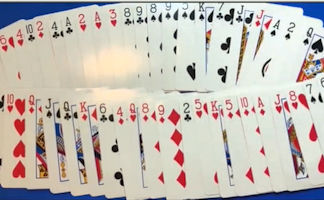

7 ShufflesThis video shows how riffle shuffling a pack of cards seven times will produce a card order never before seen since the beginning of time!. |
 |
|---|
|
|
Do you have any wonderful ideas for using playing cards to help learn mathematics? Please share your ideas here. Playing cards have been around since the ninth century. They were invented in China and spread across Europe in the fourteenth century. Though the designs on the cards have changed over the years the basic number properties have not. Because they are so popular the manufacture of high quality cards is not expensive and makes them an ideal tool for learning mathematics. |
|
Do you have any comments? It is always useful to receive feedback and helps make this free resource even more useful for those learning Mathematics anywhere in the world. Click here to enter your comments.
Ann Mason, Kingsmead School Derby
Tuesday, November 17, 2015
"NUMBER BONDS TO TEN
Remove all 10, j, q, k cards from a pack of cards.
Pupil turns over cards to create 8 separate piles.
Pairs of cards can be covered, with new cards from the pack, if the two numbers add up to 10. (Ace is taken as 1)
The aim is to get rid of all the cards - not always possible, but they soon learn to recognise the number bonds.
Could be timed to create competition as they get more confident."